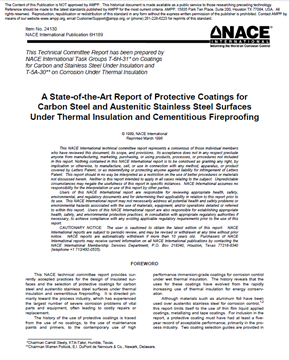Search
NACE Standards
View as
Sort by
Display
per page
MR0175-1993, Sulfide Stress Cracking Resistant Metallic Materials for Oilfield Equipment
Product Number:
53024-HD1993
ISBN:
MR0175-93
Publication Date:
1993
$179.00
MR0175-HD1999-SG, Sulfide Stress Cracking Resistant Metallic Materials for Oilfield Equipment
Product Number:
MR0175-96
ISBN:
1-57590-021-1
Publication Date:
1999
$179.00
MR0176-2012 Metallic Materials for Sucker-Rod Pumps for Corrosive Oilfield Environments
Product Number:
21303-SG
ISBN:
1-57590-099-8
Publication Date:
2012
$179.00
MR0176-2020, Metallic Materials for Sucker-Rod Pumps for Corrosive Oilfield Environments
Product Number:
MR0176-2020
ISBN:
1-57590-099-8
Publication Date:
2020
$109.00
MR-02-74-HD1974-SG, Material Requirements in Prefabricated Plastic Films for Pipeline Coatings
Product Number:
MR-02-HD1974
Publication Date:
1974
$179.00
MR0274-HD1995-SG Material Requirements for Polyolefin Cold-Applied Tapes for Underground or Submerged Pipeline Coatings-HD1996
Product Number:
21301-HD1995
Publication Date:
1995
$179.00
MR0274-Material Requirements for Polyolefin Cold-Applied Tapes for Underground Submerged Pipeline Coatings-HD1989
Product Number:
53018-HD1989
Publication Date:
1989
$95.00
NACE 24238/EFC Joint Publication-2009, Monitoring and Adjustment of Cooling Water Treatment Operating Parameters
Product Number:
24238-SG
ISBN:
1-57590-228-1
Publication Date:
2009
$109.00
NACE 6H189-1989, A State-of-the Art Report of Protective Coatings for Carbon Steel and Austenitic Stainless Steel Surfaces Under Thermal Insulation and Cementitious Fireproofing
Product Number:
NACE 6H189-1989
Publication Date:
1989
$179.00
NACE Emergency Guideline 1-HD1995-SG Maintenance Painting of Electrical Substation Apparatus Including Flow Coating of Transformer Radiators
Product Number:
21391-HD1995
Publication Date:
1995
$179.00
NACE Emergency Guideline 2-HD1997 Protective Coatings for Carbon Steel and Austenitic Stainless Steel Surfaces Under Thermal Insulation and Cementitious Fireproofing
Product Number:
21079-HD1997
ISBN:
1-57590-037-8
Publication Date:
1997
$179.00
NACE MR0176-HD1976-SG Metallic Materials for Sucker Rod Pumps for Hydrogen Sulfide Environments-HD1976
Product Number:
21303-HD1976
$179.00













